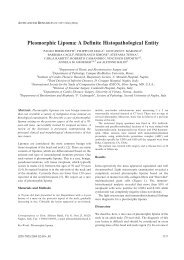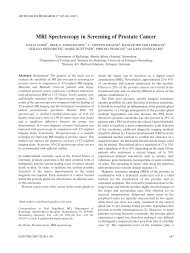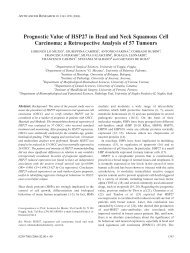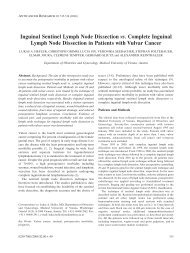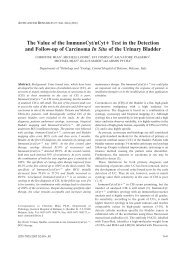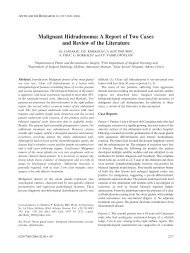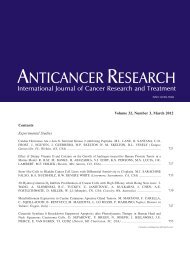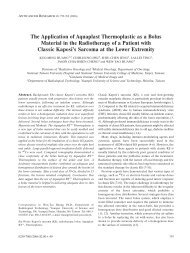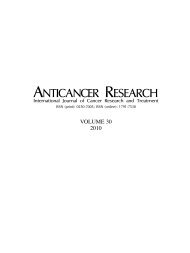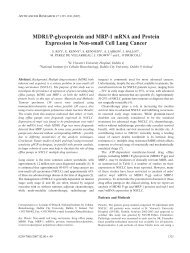ABSTRACTS OF THE 21st ANNUAL MEETING OF THE ITALIAN ...
ABSTRACTS OF THE 21st ANNUAL MEETING OF THE ITALIAN ...
ABSTRACTS OF THE 21st ANNUAL MEETING OF THE ITALIAN ...
Create successful ePaper yourself
Turn your PDF publications into a flip-book with our unique Google optimized e-Paper software.
Figure<br />
year min follow-up). A total of 20/109 patients had<br />
upgrading/upsizing after repeat biopsy, switching to radical<br />
treatment. Age, iPSA, PSA density, number of positive cores,<br />
percentage of positive cores, absolute biopsy tumor length<br />
(ABSmm) and T-stage were all considered factors potentially<br />
influencing upgrading/upsizing. GPS was not considered (all<br />
patients had GPS=3+3). Backward and forward MVLR resulted<br />
in a three-continuous variable best fit model (overall p=0.05):<br />
ABSmm (p=0.07, OR=1.20), age (p=0.37, OR=0.97), and PSA<br />
density (p=0.24, OR=6.9). A nomogram (see the figure) was<br />
built on this result. Conclusion: A nomogram including biopsy<br />
details coupled to age and PSA density can help identifying<br />
patients who have a higher probability of upgrading/upsizing<br />
after a short time in AS. More data are required to strengthen<br />
the statistical power of this preliminary analysis.<br />
This study was supported by Fondazione Monzino.<br />
217<br />
STEREOTACTIC BODY RADIATION <strong>THE</strong>RAPY<br />
FOR ISOLATED NODAL RECURRENCES<br />
<strong>OF</strong> PROSTATE CANCER<br />
Maria Grazia Petrongari1 , Sara Gomellini1 ,<br />
Stefano Arcangeli1 , Biancamaria Saracino1 ,<br />
Valeria Landoni2 , Simona Marzi2 and Lidia Strigari2 1Radioterapia Oncologica and 2Fisica Medica, Istituto<br />
Nazionale Tumori Regina Elena, Roma, Italy<br />
Aim: To evaluate the feasibility, tolerability and preliminary<br />
outcomes of stereotactic body radiation therapy in patients<br />
with nodal recurrences of prostate cancer. Patients and<br />
Methods: Between May 2006 and July 2009, 12 patients (10<br />
with isolated nodal recurrences and 2 with multiple adjacent<br />
adenopathy) underwent stereotactic body radiation therapy<br />
delivered by a linear accelerator (Linac 2100, Varian). The<br />
patient age ranged from 51 and 87 (median, 70) years. Primary<br />
1928<br />
ANTICANCER RESEARCH 31: 1807-1956 (2011)<br />
treatment was radical prostatectomy in 7 patients,<br />
prostatectomy and postoperative radiotherapy in 2 patients and<br />
exclusive radiotherapy, androgen deprivation and radiotherapy<br />
with rescue prostatectomy in 3 patients. The initial disease<br />
category according to the National Comprehensive Cancer<br />
Network 2011 was defined as intermediate, high, very high<br />
and metastatic (pN1) in 1, 2, 5 and 3 patients, respectively (1<br />
unknown). At the time of radiation therapy, 3 patients did not<br />
receive androgen deprivation, 7 patients received some forms<br />
of androgen deprivation and the remaining 2 patients were<br />
hormone-resistant. Ten patients underwent 11 C-choline<br />
positron-emission tomography/computed tomography ( 11 Ccholine<br />
PET/CT) examination, while the remaining 2 patients<br />
underwent a magnetic resonance imaging (MRI) and a CT<br />
scan, respectively, for the diagnosis of the recurrence and in<br />
order to exclude the presence of other sites of disease. All<br />
patients had a CT scan with contrast centering; 10 mm were<br />
added to the macroscopic disease or gross tumor volume<br />
(GTV) to create the planning target volume (PTV). Ten<br />
patients received a total dose of 30 Gy/3 daily fractions for<br />
lesions of dimensions between 1.2 and 2 cm (pelvic disease).<br />
Two patients received 35 Gy/5 fractions and 27 Gy/3 fractions,<br />
respectively, because of the large size of the adenopathy (5<br />
cm) and its critical location near the bone marrow (para-aortic<br />
lymph nodes). Results: There was no report of acute and late<br />
toxicity. The mean follow- up was 38 (range, 18-58) months.<br />
Eight patients had a complete response to radiotherapy with<br />
negative imaging exams ( 11 C-choline PET/CT, MRI and CT)<br />
with 3 of them never having received neoadjuvant or<br />
concomitant/adjuvant hormonal therapy; 3 patients had stable<br />
disease/partial response, and the remaining patient had<br />
progressive disease in the irradiated field. Clinical progression<br />
was observed in 9 patients after a mean time of 11 (range, 5-<br />
24) months from the completion of the stereotactic body<br />
radiation therapy. One patient had regional lymph node<br />
progression, while 3 patients had regional and distant nodal<br />
progression. Two patients experienced distant metastasis<br />
involving bones, while 3had biochemical disease progression.



